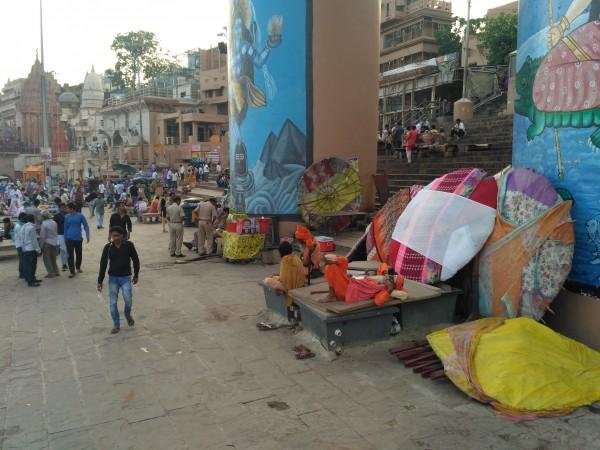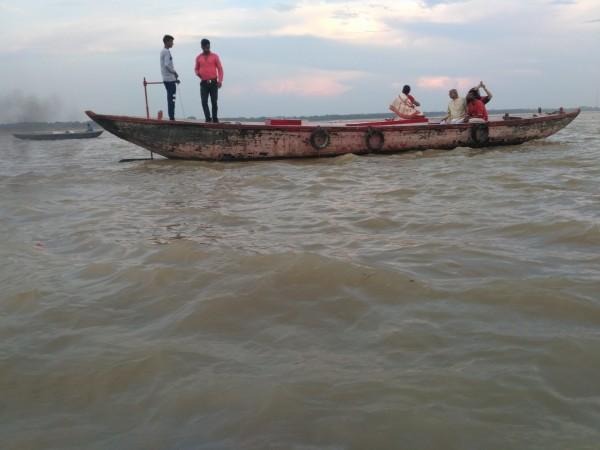
The holiest of holy places for Hindus, also known as the City of Lights, Kashi is a place founded by Shiva himself, according to legend. In fact, some believe it was the "original ground" created by Shiva and his consort at the beginning of time.
The stories and beliefs go on to say that Kashi is a place no one likes to leave, whether it be the Lord himself or the river Ganga, which takes an unexpected upward turn near the city to purportedly stay near it for longer.
A week's trip to the city and surrounding areas found us similarly reluctant to leave. There was something about the place that charmed, and that was despite all the heat, dust and milling crowds!
While the outer city is like any other and has malls, apartments and office complexes, the inner city adjacent to the temples and cremation ghats sports old, crumbling buildings jutting and touching each other across narrow cobbled lanes.
People and vehicles throng every inch of the space. In fact, the two-wheelers can take you by surprise as they seem to eject from anywhere and everywhere, moving at speeds that leave you wondering if a divine hand averts mishaps.
Occasionally, a cow ambles by.
Blaring horns of three wheelers can send ear drums ringing painfully. This sound in fact goes on past midnight.
Restaurants are few, simply because everyone eats at roadside eateries doing brisk business in samosas, kachoris and jalebis!
Milk flowing freely, khova is a sweet you can see being stirred and thickened in huge black cauldrons in most shops.
The usual jewellery shops jostle with those selling rudraksh and gems as also sari shops. Sari factory is what they call it.
Benarasi saris from Rs 300 to Rs 20,000 can be found here, but if you are not careful, you could be fooled easily.
Fooling or cheating comes as easy as praying here. In fact, the deceiver is perhaps unaware that he cheats -- whether it be the boatman who offers to take you on a ride through 365 ghats (there are only 84) or the driver of the battery-operated share autos that will fleece you for a kilometre's ride, taking advantage of the innocent is a given here.

Perhaps it's a way of living for many who depend on the pilgrims for a livelihood.
Despite all this, there is an inherent trust that weaves through life here. Dogs sleeping peacefully even as hundred feet rush by. A boy's head pops between two boats that are almost headed for a collision as he fishes in the water for something his master seems to have lost.
The saffron robed mendicant walks casually through the crowds with his sharp trishul or trident, and a cow in stomping hurry somehow winds her way up the ghat steps avoiding the seated crowd. Nobody gets up or moves aside.
Finally, there is the contrast, or "duality" if you want to call it that.
The religosity of the people pours and seeps through every act. The Kashi Viswanath temple is believed to house one of the 12 jyotirlingas of Shiva -- lingas borne out of fiery column of light.
All denominations of devotees can be seen here, fervour on their faces as they push and jostle to get closer to the linga.
Lingas are literally thrown around generously all over the city. You will find them in lane corners, inside shops and homes, anywhere.
Somebody or the other can be seen praying at these spots. Bhajans on the roadside, with a handful of people coming together, add to the vehicular din.
Beneath the noise and clamour runs a stillness one can experience on the banks of the Ganga at night.
People collect the holy Ganga water to take back home. They pray to the goddess and take a dip in the brown waters of the river. Huge crowds sit through the hour and half of the Ganga Aarti in the evening.
They believe it is a holy land and a holy river.

And yet, you will find filthy paan stains and spit everywhere on the streets. People wash their clothes using soap in the river. Shockingly, they even brush teeth and spit into the river. Nearby, a man kneads dough on the bare steps!
Some are in a tearing hurry to finish the rounds of the temples and rituals. Others are in no hurry and can be found lazing at the ghats.
Women come in traditional garbs, draped in sari and head veiled. You can also see some sporting the latest fad of torn jeans. Neither attracts unwanted attention.
Families with many members can be seen taking a boat ride, buying trinkets, talking loudly, eating junk food and in general, celebrating life.
Not more than a glance is spared for the bodies that keep coming in a constant procession, to the accompaniment of chants of "Ram naam satya hai."
In her famous book, 'Banaras: City of Light', Diana Eck writes: "Death in Kashi is not a feared death for here the ordinary God of Death, frightful Yama, has no jurisdiction. Death in Kashi is death known and faced, transformed and transcended."
The other name for Kashi is Varanasi, referring to the two rivers Varuna and Assi that meet around here and join the Ganga.
Yet another name is Avimukta, which as per the Jabala Upanishad means that which is infinite and unmanifested.
Some experts believe the word means "not forsaken", referring to the promise of Shiva never to let go of Kashi, come flood or earthquake.
No wonder then, that the city has been so resilient and risen almost out of ashes so many times. Whether it was Qutubuddin Aibak's armies in 1194 or Aurangzeb later, most of the city's temples were razed and mosques built over them.
Some of the temples were rebuilt in new locations. Like the main Shiva shrine, the Vishwanath temple which was rebuilt in 1776 by Ahilya Bai -- a Maratha queen of the Malwa kingdom.
The Jnana Vapi, or Well of Wisdom, believed to have been dug by Shiva himself, is still situated next to the mosque built over the original temple.
The place has attracted many sages down the years. Kabir, Tulsidas, Guru Nanak, Adi Shankara, and many more have found inspiration here while some like Paramahamsa Yogananda met his guru here.

Many of the Jain Tirthankaras were born here while Buddha was a frequent visitor. The place of his first sermon after realisation, at Sarnath, is close by.
Whether it is the blessings of these enlightened souls or even more ancient reasons, Kashi can be puzzlingly enchanting.
In the words of an Indologist and Sanskrit scholar PV Kane: "There is hardly any city in the world, that can claim greater antiquity, greater continuity and greater popular veneration than Banaras. Banaras has been a holy city for at least thirty centuries. No city in India arouses the religious emotions of Hindus as much as Kasi does."
To quote the oft-cited Mark Twain quote, 'Varanasi is older than history older than tradition, older even than legend, and looks twice as old as all of them put together'. One does not know what exactly made him say this.
But the proof of its ancient existence was unearthed by a former faculty of the Banaras Hindu University (BHU). Prof Vidula Jayaswal and team who excavated areas aroundRamnagar and Akatha a couple of years ago found remains that suggest the settlements go back to 1800 BC. A more recent study conducted by IIT-Kharagpur where 100-metre wells were dug all over Varanasi threw up evidence of continuous settlement at least till 2000BC, making it as old as Indus Valley civilisation. The team believes that this could be pushed back to 4500 BC.
It could be this ancient connection to so many million kindred souls that have passed by here that keeps one bound to Kashi. I know that I would like to go back again, to explore a little bit more of the chaos and peace and try decode the spell.

















